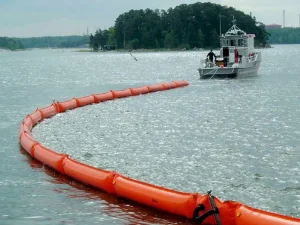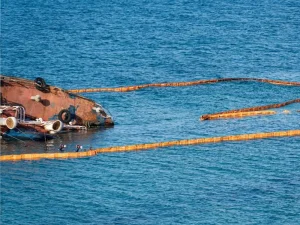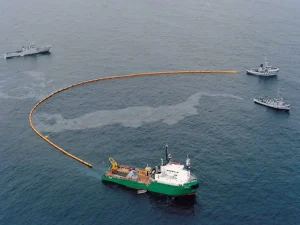Oil is one of the leading causes of contamination in water bodies. However, marine industries are a significant source of oil pollution for oceans. They use marine vessels that drain oil in the oceans. Oil-absorbent booms come into the scene to tackle this issue. But the question arises: How do oil-absorbent booms work?
It is crucial to know their work because they save marine life. HOW? Oil forms a layer on the surface of water. This layer hinders sunlight from reaching deep and causes fish to die. This depletion of marine life somehow affects our environment, too. Are you curious about these sorbent booms? Let’s discuss the basics of their work and understand their work.
Overview of Oil-Absorbent Booms

Oil-absorbent booms are tubular structures that remove oil from water. They are made of polypropylene, which is oleophilic and hydrophobic. In other words, it attracts oil and repels water. This property allows them to float and collect oil in large quantities for a long time.
However, each oil absorbent has a limited capacity to store oil. When it is filled with oil, it is crucial to replace it. Otherwise, it will sink and drain all stored oil into the water. This can affect the whole process. Moreover, they come in different sizes for various water bodies.
Oil-absorbent booms not only collect water but also prevent it from spreading. When placed in water, they surround oil spills. Therefore, they are effective for large water bodies, such as oceans. Hence, marine industries use them widely.
Oil absorbents must be strong to resist harsh environments. They must be robust and should not rupture. For this reason, synthetic fiber is preferred in their making. It is not only a strong material but also eco-friendly. For example, you can recycle and reuse it.
Components of Oil-Absorbent Booms

Oil-absorbent booms are made of several components. All these components play a part in their efficient working. Remember, you won’t understand their proper working without knowing their parts. The section below will explore different significant components of oil absorbents.
- Outer Fabric: The outer fabric is the outermost part of the oil absorbent. All other components are attached to it. It ensures the efficient working of oil booms and is made of solid material to bear pressure and temperature fluctuations.
- Absorbent Core: The absorbent core is the layer beneath the outer fabric. It is made of polypropylene that absorbs maximum oil. To ensure its efficient operation, it does not absorb water.
- Floatation Elements: Floatation elements are present in the inner core of the oil absorbents. They help the oil-booms to flat on the surface of water. They have enough capacity to hold the maximum amount of oil.
- Connectors and Fasteners: Oil booms vary in size. Large water bodies are connected to cover a larger area, which speeds up their work. Remember, several connectors are present at both ends of each oil absorbent. They are in the form of clips, ropes, or hooks.
- End Caps and Seams: End caps prevent oil from draining out. They act as lids and are present at the ends of oil booms. Ensure they are tightly closed and withstand the internal pressure of oil.
How Oil-Absorbent Booms Work?

Have you grasped the basic concept and become familiar with the components of these marine booms? I am sure you have! Want to know how they work now? Remember, their work is not straightforward. It involves a series of consecutive steps. Let’s examine each step in detail.
1- Deployment and Containment
It is the first and crucial step in the working of oil-absorbent booms. Different-sized oil booms are shifted to areas with significant oil spills. Marine industries need to remove oil from large water areas, so those oil booms are connected with fasteners.
When placed in water bodies, they perform the function of deployment and containment. This process involves surrounding oil spills. For example, when oil booms float on the water’s surface, they form a fence around oil spills. This fence prevents the oil from spreading and reduces the extra effort.
2- Oil Absorption
After deployment and containment, the oil absorption process begins. As I mentioned above, oil-booms are made of particular approbation elements. Those elements are present inside the main body and perform the task of absorption. How do they absorb oil? They are made of synthetic fiber.
Synthetic fiber is well-known for its dual functionality of hydrophobic and oleophilic. It means oil-booms only absorb the oil and leave the water behind. This process makes it easy for oil-booms to float for a long time. Because water addition can make it heavy and sink them.
3- Floating on Water
The oil-booms are lightweight and keep floating on the surface of water. They continue floating and collecting the oil for a long time. Marine industries sometimes add extra buoyant agents to boost their floating efficiency. They prevent oil-booms from skin after saturation of oil. Moreover, they also ensure that waves and shocks do not affect oil-booms’ floating.
4- Saturation and Replacement
I said above that each oil-absorbent boom has a limited capacity for oil storage. Once capacity is reached, they reach the point of saturation. This means they have absorbed the maximum quantity of oil and have no more capacity left. If oil booms accidentally cross this limit, they will start draining the oil. Therefore, booms are replaced with new ones immediately after the oil saturation.
5- Disposal and Cleaning
As I stated above, old oil booms are replaced with new ones. Here, the question arises: Where do the old oil booms go? They are disposed of or reused, depending on the situation. For example, some oil booms cannot withstand harsh environments. Therefore, marine industries dispose of them after a single use. However, other types of booms are reused after cleaning them. Proper cleaning enhances their functionality.
Types of Oil-Absorbent Booms
There are several types of oil-absorbent booms. However, based on water bodies, oil-booms are classified into three types. Let’s discuss each type and its specialty.
1- Marine Booms
Marine industries mainly use these oil booms. They are made of robust material to withstand the harsh conditions of oceans. Booms are primarily large, though many can be connected for the required length. Moreover, their large size makes it difficult to relocate them. For this reason, they use eco-friendly materials and last in the ocean for several months.
2- River Booms
River booms clean oil spills from various rivers. They are designed especially for the river environment. For example, rivers vary in width and depth, right? Therefore, these oil booms have enhanced flexibility. They can effectively work in those varying depths and widths. Moreover, they are smaller than marine booms, making them easy to handle and relocate.
3- Harbors Booms
These oil booms are used to secure calm water from oil pollution. You must have seen that the sea shores are badly contaminated by oil. They are parking areas for marine vessels and other traffic. Therefore, it is crucial to clean them to save our environment. For this purpose, harbor booms are used.
Harbor booms have a straightforward design because they do not have to face heavy waves and socks. Therefore, they last a long time and collect a large quantity of oil. Moreover, they are straightforward to replace and relocate.
Advantages of Oil-Absorbent Booms
Oil-absorbent booms have extraordinary features and functions. They make it easy to clean contaminated waters thoroughly and offer several other advantages. Let’s take a short glimpse at those pros.
- You know that oil booms create barriers around oil spills. This offers marine industries a speedy and easy way to clean vast ocean regions.
- Oil-absorbent booms are versatile in their usability in different environments. They can be effective in calm rivers and ocean waters.
- Oil spills highly affect our environment and marine life. They can deplete the balance of the ecosystem. But oil booms save our environment and marine life at the same time.
- They have a simple design and are easy to operate. Moreover, their flexible design allows easy relocation and adjustment.
- Oil booms are reusable, can last a long time, and decrease overall costs. Small industries can also benefit from them.
- They are made of synthetic fiber, which is easily recyclable. This material makes them eco-friendly in case of wear and tear.
Frequently Asked Questions
How long does oil absorbent take to work?
It mainly depends on the length and size of water bodies. However, an average oil absorbent takes about 24-28 hours for complete oil absorption.
Is oil absorbent flammable?
Almost all oil absorbents are made of synthetic fiber, which is inflammable. However, some are made of cellulose, which is flammable. However, they are made for special environmental conditions.
What are the disadvantages of an oil boom?
The main disadvantage of an oil boom is its ability to rupture, as it is made of lightweight material. Thus, even slight saturation can cause oil to leak into the water and disrupt the entire process.
Conclusion
In this article, I have explained the easy-to-understand workings of oil-absorbent booms. These oil booms work on the principle of adhesion. For example, they are made of synthetic fiber. This fiber adheres to the oil due to its low surface tension and leaves the water behind.
Oil-absorbent booms are made of several components. All those components contribute to the efficient working of these oil booms. Moreover, there are different types of oil booms. These types are specific to various environments. However, the easy have simple and flexible designs, which makes them easy to operate.
